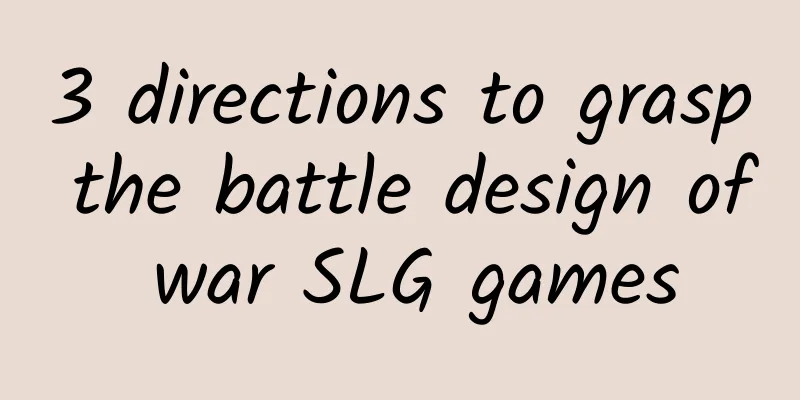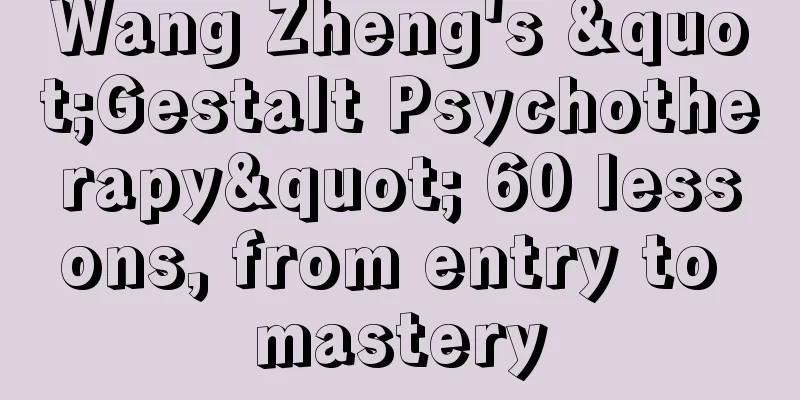3 directions to grasp the battle design of war SLG games

|
1. Overview With the popularity of Game of War and Clash of Kings, more and more SLG games are entering the market. There is an interesting thing about the current SLG games, that is, most of them do not have battle performances, but describe the battles in the form of battle reports. Recently, GL released a war game called Empire Domination, which added battle performances, but to be honest, it is not very good, because the battle rules behind it are not very outstanding. This article only discusses GOW/COK type SLG. 2. Battle Rules 1. Basic settings Let’s put aside the question of whether SLG needs combat performance for now, but there must be combat rules in the background. First, let's explain my ideal combat setup:
Under this basic setting, the core of Slg's combat rules lies in five parts: winning and losing rules, military type settings, troop quantity settings, and battlefield settings. (II) Battle Rules 1. Winning and losing rules There are only two types. The first one is that whoever's troops are wiped out first loses, as detailed in the battle performance of Empire Domination. However, this usually sets a damage coefficient, otherwise it would be a bad experience if all the troops were killed in one battle. The second type has a fixed number of rounds, and whoever has more soldiers killed or more combat power damaged loses. 2. Arms Setting There are also two parts here. First, is the setting of arms. Setting the ratio of defense and attack capabilities of different arms is the first step in the setting. Ensuring the balance of individual soldier combat power is the first thing to do. On top of that, restraint is an easy way to add strategy to the game, so everyone is doing it. For example, GOW also has the design of tactical arms (strongly restraining a certain arm). The restraint relationship between arms is mostly achieved through damage coefficients, and the specific value depends on the needs. The second part to consider is the combat power improvement coefficient brought by the level jump of the soldiers. Here, the setting of the soldier attribute improvement coefficient and the combat damage formula is designed. The level suppression of soldiers should not be too obvious. In general, I prefer to use the division damage formula, which I will not elaborate on here. Specific details such as the improvement value of the soldier's upgraded ability and which specific formula variant to use need to be comprehensively considered. The second is the positions of different types of troops. This is also necessary, otherwise the ranged soldiers will be attacked by the melee soldiers at the beginning, and the picture is too beautiful that I dare not look at it. The setting of the positions and ranges of different soldiers combined with the restraint relationship between the soldiers is the part that can make the game's combat strategy outstanding. Generally speaking, they are: infantry/spear, cavalry, and bow designs. But in fact, there are many variations here, that is, formations. If we compare battles to the cards we are familiar with, then the first game to do a good job of positioning and restraint is Dota Legend. You can imagine the improvements in gameplay it brings. 3. Setting the number of troops This is the part I want to emphasize, and I will use the idea of the Lanchester equation to explain it. How the number of troops affects the battle situation is something that needs to be carefully considered in an SLG game. To consider how to design it, we first need to know: how it affects the battle situation. Assume that the combat power of a unit is equal to the sum of the combat power of individual soldiers, that is: Recalling the basic rules, the basic unit in turn-based combat is the troop, which means that first, the combat effectiveness of the smallest unit actually participating in the battle is actually determined by the individual soldier's ability and the number of troops; second, as the rounds progress, the number of troops will inevitably decay, that is, the combat effectiveness of the troops is also constantly decreasing. Now, we are going to discuss the part using the Lanchester equation. Since the combat rules treat a unit as a whole and perform combat calculations as a unit, the combat conforms to the Lanchester square law: M&N=initial force, M(), N()=remaining force after event t, a&b=number of enemies killed by a single soldier per unit time This means that the impact of the number of troops on the battle is squared. Then the crushing due to the number of troops will be very obvious, and this experience is very bad. For example, your soldiers are higher than the enemy's level and their combat power is twice that of the enemy, and the enemy only needs to have 1.415 times more troops than you to defeat you. Therefore, the number of troops and combat power cannot generally be made into a simple linear relationship, but should satisfy the following: The specific choice of x value is determined by the needs: the proportion of the impact of the number of troops and individual soldier capabilities on the combat effectiveness of the troops. 4. Battlefield setting Field battles, sieges, or multi-player team battles. The rules here mainly consider the advantages of both the attacker and the defender in different scenarios. Generally speaking, there is no advantage in field battles. Sieges are an advantage for the defenders. GOW/COK/Imperial Domination all give the defenders a huge advantage here: first, traps, and second, most of the defenders' losses will be wounded. This is partly due to asynchronous considerations, and partly because castles can be attacked by multiple people. Team up to fight. There are two situations: many to one, and many to many. In many to one, since the defenders have injured many wounded soldiers, they can recover at a lower cost, thus deriving a strategy of recovering wounded soldiers in seconds. In many to many, the assembled castle has reinforcements, and at this time, the defenders have a complete advantage. Another issue that needs to be considered in team battles is how to integrate the troops of different players into the combat power of the entire legion. There are many rules that can be explored in depth in this regard. The simplest method is of course to simply add them up, but this will reduce the depth of team battles. In fact, it is entirely possible to implement positional rules in team battles. The specific situation will be determined based on the actual combat rules. However, there is still a lot of room for improvement and creativity. The current set of rules puts the attacker at a huge disadvantage when the defender is online, and once the defender is offline, the attacker will continue to plunder the defender's resources after the first loss. As far as this result is concerned, there is still a lot that can be tried for the rules of these battle scenarios. 3. Actual Effect In actual games, players will only have a general impression of the specific rules. Without combat performance, players may not necessarily understand the actual impact of troop numbers and soldier levels on combat. In fact, players' more strategic experience comes from troop allocation: formation & troop number ratio. In terms of formation, the harder the front row is, the better. As for the other parts, it mainly depends on the balance of the formation itself in the game and the enemy's formation settings. In terms of quantity ratio, assuming that the number of troops affects the combat power of troops in the form of (number of troops ^ x, x < 1) as mentioned above, then when the total number of troops is fixed, it may be more efficient to split the total force into multiple units instead of concentrating them in two or three units. In addition, there is a position setting, so the more the front row, the better, so how to make the front row too strong in actual combat is also a place that needs constant adjustment. |
>>: Apple officially released iOS 9, which seems quite tempting
Recommend
How much does it cost to join Baidu AiPurchasing? How can I join Baidu AiPurchasing?
In October 2018, Baidu launched the enterprise B2...
Panshi SEO Training: Are original articles really effective for SEO?
I have seen many articles about the importance of...
13 creative ways to play events, a must-have for marketing in 2020!
The homogeneity of current market competition is ...
13 creative ways to play events, a must-have for marketing in 2020!
The homogeneity of current market competition is ...
What are the benefits of having a high number of likes on Douyin? What is the function?
The most direct way for apps like Tik Tok , Kuais...
How much does it cost to find an African to record a birthday blessing video?
In recent days, photos and videos of African blac...
Practical sharing: 90 upgrades of mini programs, 3 things for operators to think about
From the opening of the mini program internal bet...
360 advertising promotion costs, billing methods, and click prices!
What is the billing method for 360 search promoti...
Ouyang Fukua's "Phone Flirting" Video Tutorial
Ouyang Fukua's "Phone Flirting" tut...
City selection controller
Source code introduction: city selection controll...
How to use AFNetworking in Swift
[[147119]] Apple released the new Swift language ...
A comprehensive inventory of Toutiao products and practical sharing of strategy optimization!
In recent years, Toutiao has developed rapidly, a...
What is the market price for a bottle of 52-degree platinum cellar-aged wine (Kweichow Moutai Distillery)?
How much is the market price of a bottle of 52-de...
What knowledge do you need to learn to be a programmer?
Anyone who asks this question should be beaten, d...
How many days will Shanghai be under lockdown in 2022? How long will it take for the closed community to be unsealed and return to normal? Attached is the latest news on the epidemic!
The epidemic situation in Shanghai, my country is ...









